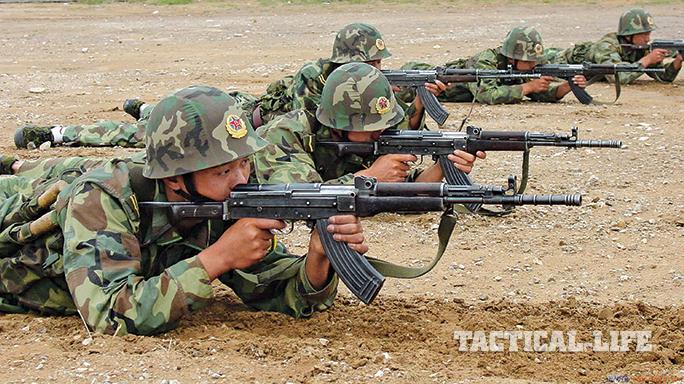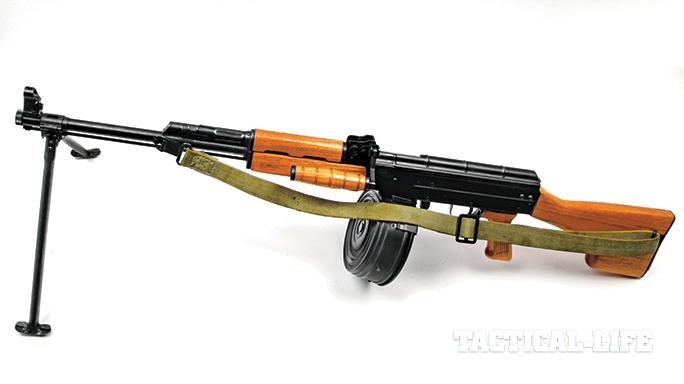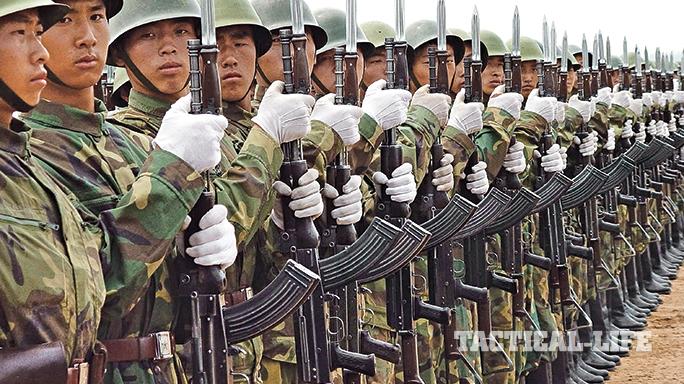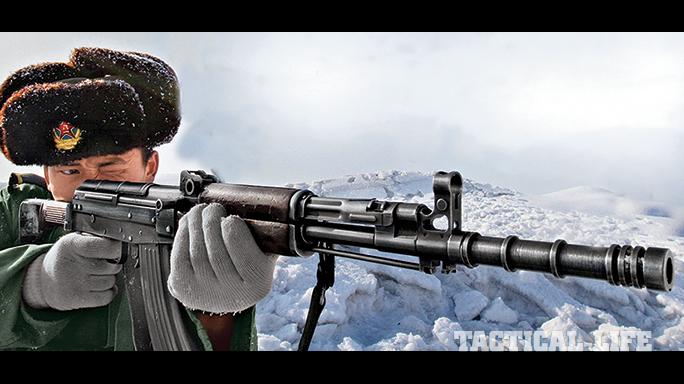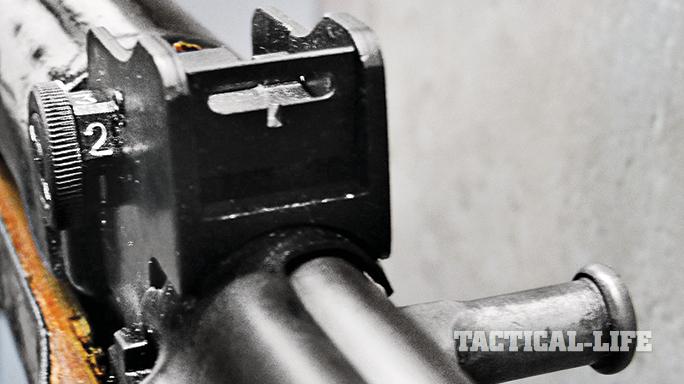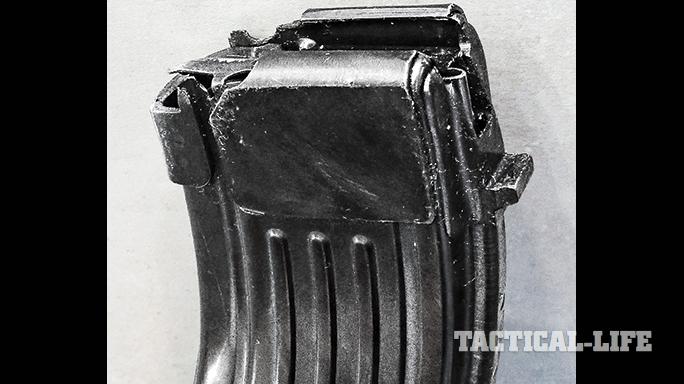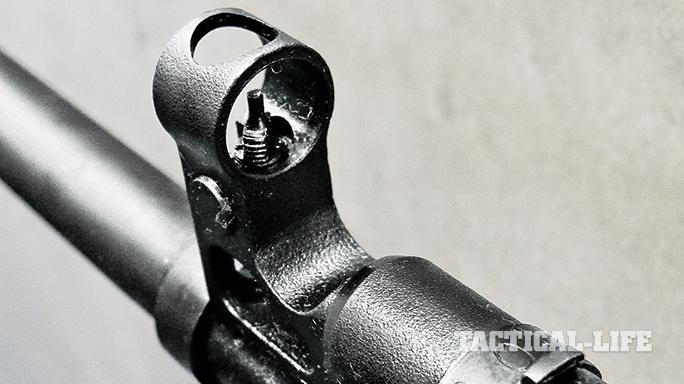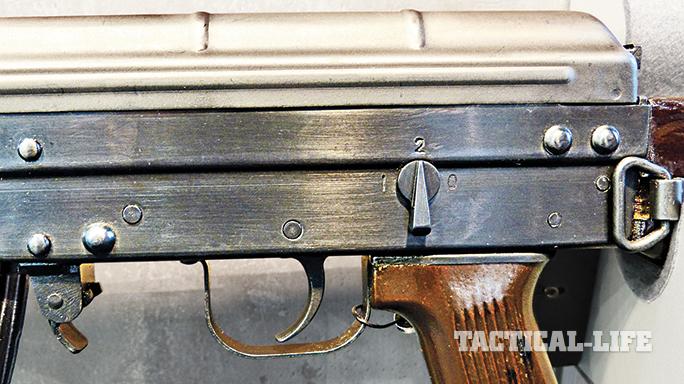During the early years of the post-WWII period, the newly established People’s Republic of China (PRC) was a close “friend” to the Soviet Union, so it was natural for the country to adopt the weapons of a more advanced ally.
In 1956, the Chinese military adopted two Soviet designs, both carrying the same Type 56 designation and both being chambered for Soviet 7.62x39mm ammunition. One was the semi-automatic Simonov SKS carbine, the other was the AK-47 assault rifle. Both weapons were made in large numbers and used by the People’s Liberation Army of China (PLA), as well as exported into various Third-World countries.
- RELATED: Chinese-Type SKS Rifle 56 7.62x39mm
- RELATED: Chinese Type 56 7.62x39mm
The Type 56 assault rifle, as initially adopted by the PLA, was an almost exact copy of the Soviet AK with a milled receiver. The only notable differences were the markings in Chinese, instead of Russian, and the folding, non-detachable, spike-shaped bayonets, which replaced the original detachable knife bayonets of Soviet origin. These two weapons were complemented by the 7.62x39mm Type 56 belt-fed light machine gun, which was nothing more but a license-built Degtyaryov RPD light machine gun, which was also of Soviet origin.
Advertisement — Continue Reading Below
Later on, following significant disagreements between the PRC and the USSR during the 1960s, China decided to develop its own small arms, based on the earlier designs. The first domestically designed and mass-produced assault rifle was the Type 63. As its name implies, it was initially adopted by the PLA in 1963. It is an interesting development because it represents a mix of features taken from other designs, mostly from the AK and the SKS. In particular, it combined an AK-style rotary bolt locking and detachable magazine feed with an SKS-type stock and a short-stroke gas piston. Like its predecessor, the Type 63 rifle fired 7.62x39mm ammunition of Soviet origin.
Being the first more or less indigenous weapon of Chinese design, the Type 63 rifle was not without certain flaws. Furthermore, combat experience, gained by the PLA during the Sino-Vietnamese border conflicts of the late 1970s, suggested that the PLA was years behind the Vietnamese Army in terms of infantry armaments. Furthermore, available Type 56 assault rifles were found to be less accurate than desired.
As a result of these revelations, a new research and development program was initiated in April of 1979. Using previous experimental weapons as a base for a new rifle, at least two design teams entered the competition. Apparently, the two competing designs were labelled as Type 81 and Type 82, both consisting of a basic infantry rifle and a light machine gun/squad automatic weapon, which was intended to replace old Type 56/RPD machine guns.
Advertisement — Continue Reading Below
The Type 81 design won the trials, and was approved for initial production in 1983. After extensive field trials, it was formally approved for mass production and general issue in 1986, as an interim measure until the development of the small-bore rifle system (which later became the 5.8x42mm Type 95) was completed. Like many other interim measures, the Type 81 small-arms family had a much longer service life than initially anticipated. In fact, it is still employed byPLA and People’s Armed Police (PAP) troops acrossmainland China, being gradually replaced by the new 5.8mm Type 95 small-arms family.
Versatile Platform
The Type 81 was more than a single assault rifle—it was a family of infantry firearms, like the Soviet AKM/RPK family. Type 81 weapons were made as an assault rifle with a fixed stock, an assault rifle with a folding stock (Type 81-1), and a heavy barrelled Type 81 Squad Automatic Weapon/light machine gun. The latter was fitted with a bipod and issued with 75-round drum magazines instead of the typical 30-round boxes.
Advertisement — Continue Reading Below
“The Type 81 was more than a single assault rifle—it was a family of infantry firearms, much like the Soviet AKM/RPK family.”
It must be noted that the folding-stock Type 81-1 rifle, which was initially intended for paratroopers, later became the standard issue weapon for all troops. Despite being externally somewhat similar to the AK-47, it is significantly different from it; its most easily distinguishable feature being an exposed part of the barrel, with the foresight moved back. This was done to be able to fire rifle grenades from the barrel. Type 81 rifles replaced most of the obsolescent Type 56 assault rifles and carbines, as well as Type 63 rifles, in most PLA units, and saw some action in border clashes between China and Vietnam during the late 1980s.
Compared to the Type 56/AK-47 rifles, the Type 81 has some prominent features. It uses a longer barrel and a more rigid receiver made of thicker sheet steel. It also features a lighter bolt group combined with a gas regulator, which allows for more smooth operation under normal conditions, resulting in increased accuracy in both single shots and automatic fire. It also has a bolt hold-open, though it requires special magazines that are not compatible with the AK family. The safety selector is relocated to the left side and the sights also are different from the Type 56/AK-47.
Advertisement — Continue Reading Below
The PLA was a major user of the Type 81 small-arms family, but apparently not the sole one. More than a few Type 81-1 rifles were issued to the ranks of Chinese armed police (PAP) forces. Export sales were made to Algeria, Burma and some other states, mostly in Southeast Asia and Africa.
The Chinese state-owned Norinco Corporation also produced semi-automatic-only versions of the Type 81 weapons for export to Western civilian markets. For a short time, semi-automatic Type 81 weapons, based on the Type 81-1 rifle and Type 81 LMG, were available to U.S. customers through ChinaSports Inc, trading out of Santa Fe Springs, California. Chambered to its “native” 7.62x39mm ammunition, these weapons were similar to their military prototypes, except for the obvious inability to fire in full auto and less obvious safety arrangements on the Type 81S rifle.
For some reason, this model had its safety located inside the triggerguard, while its Type 81MGS “heavy barrel” rifle and their military ascendants had safety switches located on the left side of the receiver. U.S. importation of these weapons was eventually ceased. Norinco also manufactured a rare, 5.56mm (.223) caliber semi-automatic variant of the Type 81S rifle, known as EM-356. It is visually different from 7.62mm Type 81S rifle by having the gas block moved farther forward on the barrel, and using a 30-round stamped steel magazine, which was borrowed from the 5.56mm Type 88S (AK-74 clone) semi-automatic rifle, also offered by Norinco. Another peculiar feature of the export models was an additional type of folding stock. While military-issue Type 81 rifles featured either a fixed wooden stock or side-folding metallic stock, Type 81S rifles also were offered with an underfolding AKS-type shoulder stock, in both 7.62mm and 5.56mm variants.
Advertisement — Continue Reading Below
The latest variant of the Type 81 family of weapons is the 5.8mm Type 87 rifle. It is mechanically similar to Type 81-1, but it is adapted to new small-bore Chinese service ammunition, the 5.8x42mm DBP-87. Other visible changes include plastic furniture and an L-shaped side-folding shoulder stock, also covered with plastic. Produced in relatively small numbers, the Type 87 rifle was used as a test bed to refine 5.8mm ammunition prior to its full-scale adoption, along with the radically different Type 95 small-arms system, which consists of a rifle, carbine and a light machine gun, all based on the same bullpup layout with plastic body.
It appears that the Type 81 small-arms system is gradually being phased out of frontline PLA units, which now use 5.8mm Type 95 small-arms systems. However, the PAP still possesses sizeable stocks of the Type 81 rifles, which are issued on regular basis, especially in more remote areas of the country. Also, semi-automatic conversions of the former military Type 81 and Type 81-1 rifles were displayed at IWA-2014 exhibition in Nuremberg, Germany. Apparently, Norinco obtained stocks of ex-military Type 81 weapons in serviceable condition and, after refurbishing and converting them to semi-automatic-only, plans to sell them to the European shooting public.
Gun Details
Advertisement — Continue Reading Below
The Type 81 is a gas-operated, magazine-fed, select-fire weapon that fires from a closed bolt. It uses a short-stroke gas piston that’s located above the barrel and a three-position gas regulator (two positions for firing in normal and harsh conditions, marked “1” and “2,” and one marked “0” for launching rifle grenades). The bolt group features an AK-47-type rotating bolt that locks into the machined barrel trunnion, pinned to the stamped steel receiver. The barrel bore and bolt group are chrome-plated to ensure longer service life.
Type 81 rifles also feature a bolt hold-open, which catches the bolt in the open position after the last round has been fired from the magazine. There’s no separate manual bolt release lever; it has to be released by pulling it slightly back from locked position and then releasing the handle. The safety selector switch is located at the left side of the receiver, just above the pistol grip, and can be easily operated with the right-hand thumb. Its settings, however, are counter-intuitive for American shooters accustomed to AR-15/M16 type selectors. The Type 81’s selector works clockwise from the three o’clock position, with its settings being “0” (safe), “2” (full auto) and “1” (semi-auto).
The gun’s open sights are marked from 100 to 500 meters, with the protected post front sight being mounted just ahead of the gas block, leaving the front portion of the barrel free for the rifle grenade launcher. The rear sight has an unusual T-shaped aperture, with the small U-shaped notch at the bottom being used for actual aiming. Range adjustments are done by rotating knobs located on both sides of the rear sight base; the knobs are marked for range in hundreds of meters (from 100 to 500). Ammunition is fed from specially designed 20- and 30-round stamped steel magazines, or from 75-round drums intended for the Type 81 light machine gun. Twenty-round magazines are rare and believed to be a heritage of the previous Type 63 rifles.
Advertisement — Continue Reading Below
The furniture (pistol grip and forend) is normally made of wood. The most common Type 81-1 rifles feature a side-folding shoulder stock, made from sheet steel stampings, and are fitted with unusual plastic covers, which, apparently, are intended as a grip for a bayonet thrust that also can double as a rudimentary cheekrest, protecting the shooter’s face from contact with bare steel. When not required, the shoulder stock folds forward and to the right.
The Type 81 light machine gun is essentially similar to Type 81 rifle, with certain modifications. Most importantly, it has a longer and heavier barrel, fitted with a permanently attached, folding bipod. The front sight base is mounted at the muzzle end of the barrel, allowing for a noticeably longer sight radius. The rear sight is graduatedto 800 meters. It is fitted with a fixed, wooden shoulder stock and a folding carry handle, located at the frontof the receiver.
The Type 81 series of Chinese weapons shows a unique Sino take on Soviet-style weapon design, delivering a rifle design that is simultaneously idiosyncratic and familiar. No matter what though, the series has proven to be a tough and reliable domestic Chinese offering that has earned a reputation for performance.
Advertisement — Continue Reading Below
